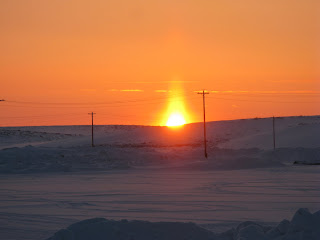 |
| Easter is a time of renewal in Kotzebue. |
While Rick and I were out yesterday, we saw many cars parked at the Baptist Church along Front Street. Friday night was filled with praise and worship at the local churches. There are many churches located in this hub city above the Arctic Circle. Represented are the Roman Catholic Church, Episcopal, Quaker (The Friends Church), several Baptist churches, the Church of the Latter Day Saints, and the Seventh Day Adventist Church.
Perhaps there are so many churches in this village of 3300 because the Inupiat people throughout history have been deeply spiritual. Their culture was at one time guided by their 17 Inupiaq values. And at the heart of those values is a respect for elders, for others, and a respect for nature. When the missionaries came to this foreign land in the early 1900s, these people were converted to Christianity. Their native practices were shunned and their children forced to attend schools far away from their parents. As time went on, the Inupiaq values were no longer taught to their children. But those values remained in the hearts of the elders.
Today there are many attempts to bring back the old ways, including the Inupiaq values. At the club, we are teaching the kids those values. The youth are recognizing their use and importance in their everyday life. At the recent Arctic Circle Spring Festival, there were traditional activities including Eskimo football, an ice fishing derby, and harpoon contest, and snowshoeing race. At the awards banquet where the winners of the Kobuk 440 were announced, Eskimo dancing and drumming entertained attendees. Families recovering from addiction may a visit to the old Spud Farm as part of their rehabilitation. These families learn the Inupiaq values and engage in traditional subsistence activities.
 |
| Kivalina is located on an 8-mile barrier reef. near Chukchi Sea. |
The Alaska Commercial store in Kotzebue displayed the western symbols of Easter. A large display at its entrance contained Easter baskets, candy and lilies beginning early this month. Easter candy was a favorite purchase among youth and adults throughout Lent. Kids showed up at the club on Friday buzzed out on sugar from candy eaten at school that day.
The peace and relief is in the air in this Eskimo Village. May the blessings be realized in Kotzebue, Kivalina and the other villages throughout the Northwest Arctic Borough on this day. May we all enjoy the plentiful light in the sky and the warmer temperatures as the season of Melt continues.


